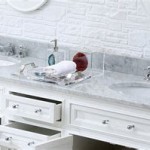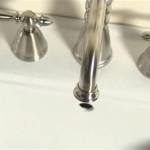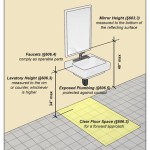Small Bathroom Tiles: Design Images and Simple Strategies
Designing a small bathroom presents unique challenges. Space is limited, and the goal is to create a functional and aesthetically pleasing environment. Tile selection plays a crucial role in achieving this, as it can influence the perceived size, light, and overall style of the room. Careful consideration of tile size, color, pattern, and material is essential. This article explores various tile design ideas and simple strategies, illustrated with design images, to help optimize small bathrooms.
The right tile choices can visually expand the space, making it feel less cramped and more inviting. Conversely, incorrect tile selections can exacerbate the feeling of confinement and create a visually cluttered appearance. Therefore, a strategic approach is needed, focusing on maximizing the impact of each tile element.
Before delving into specific design ideas, it is important to understand the fundamental principles guiding tile selection for small bathrooms. Light colors reflect more light, making the space appear larger. Larger tiles minimize grout lines, creating a less busy and more seamless visual. Simple patterns avoid overwhelming the small space. Finally, consider the overall style of the bathroom and choose tiles that complement it. These principles, when applied thoughtfully, can transform a small, uninspired bathroom into a stylish and functional space.
Leveraging Light Colors and Reflective Surfaces
Light colors are a staple in small bathroom design. They reflect light, visually expanding the space and creating a brighter, more open atmosphere. White, cream, light gray, and pastel shades are all excellent choices for bathroom tiles. While white is a classic and timeless option, it can sometimes feel sterile. Introduce warmth and personality by incorporating subtle variations in texture or pattern. For example, a textured white subway tile can add depth and visual interest without compromising the overall lightness of the space.
Consider using glossy or polished tiles to enhance light reflection. These surfaces bounce light more effectively than matte finishes, further contributing to the feeling of spaciousness. However, it is important to be mindful of glare, especially if the bathroom receives a lot of natural light. Position lighting strategically to minimize glare and create a comfortable ambiance.
Mirror placement is also critical in maximizing light reflection. A large mirror, or even a mirrored wall, can double the perceived size of the bathroom. Combining light-colored tiles with strategically placed mirrors can create a dramatic effect, making the small bathroom feel significantly larger and brighter.
One can opt for lighter shades for the tiles on the walls and a slightly darker shade for the flooring to ground the design and prevent the space from feeling too ethereal. This creates a visual anchor and adds a subtle contrast that enhances the overall aesthetic. However, avoid overly dark colors for the floor, as they can absorb light and make the space feel smaller.
Another approach is to use light-colored grout with light-colored tiles. This minimizes the appearance of grout lines, creating a seamless visual that further enhances the feeling of spaciousness. Dark grout can create a busy pattern and draw attention to the small size of the bathroom.
The Impact of Tile Size and Layout
The size of the tiles used in a small bathroom can significantly impact the perceived size of the space. While smaller mosaic tiles can add intricate detail, they can also create a busy and cluttered appearance, making the bathroom feel even smaller. Larger tiles, on the other hand, minimize grout lines and create a more seamless visual, visually expanding the space.
Large-format tiles, typically 12x24 inches or larger, are an excellent choice for small bathrooms. They cover a larger area with fewer grout lines, creating a cleaner and more modern aesthetic. When using large-format tiles, it is important to ensure that the subfloor is level to prevent lippage (uneven tile edges). Professional installation is often recommended to ensure a flawless finish.
The layout of the tiles is also crucial. Running tiles horizontally can visually widen the bathroom, while running them vertically can create the illusion of height. Consider the proportions of the bathroom and choose a layout that best complements its shape. For example, in a narrow bathroom, running the tiles horizontally can make the space feel wider and less cramped.
Another technique is to use the same tile on both the walls and the floor. This creates a continuous and seamless visual that further enhances the feeling of spaciousness. Choose a durable and slip-resistant tile for the floor, especially in wet areas like the shower.
Consider the scale of the bathroom fixtures when choosing tile sizes. If the bathroom has a small vanity or toilet, avoid choosing excessively large tiles that may overwhelm the space. A balanced approach is key to creating a harmonious and aesthetically pleasing design.
Simple Patterns and Textures for Visual Interest
While simple designs are generally recommended for small bathrooms, incorporating subtle patterns and textures can add visual interest and prevent the space from feeling bland. Avoid overly complex or busy patterns that can overwhelm the small space. Instead, opt for subtle textures, geometric patterns, or simple color variations.
Subway tiles are a classic choice for bathrooms, and they can be arranged in various patterns to add visual interest. A classic horizontal layout is a safe and timeless option, but consider experimenting with other patterns, such as herringbone, vertical stack, or a brick bond pattern. Just be mindful of maintaining a sense of simplicity and avoiding overly complex designs.
Textured tiles can add depth and dimension to the bathroom without overwhelming the space. Choose tiles with subtle textures, such as a rippled or hammered finish, to create a tactile experience and add visual interest. Textured tiles can also help to improve slip resistance, making them a practical choice for bathroom floors.
Another approach is to use different shades of the same color to create a subtle gradient effect. This can add depth and visual interest without introducing contrasting colors that might make the space feel smaller. For example, use a light gray tile on the upper walls and a slightly darker gray tile on the lower walls to create a subtle sense of depth.
Consider using accent tiles to add a pop of color or pattern. An accent tile strip behind the vanity or in the shower can add visual interest without overwhelming the space. Choose an accent tile that complements the overall color scheme and style of the bathroom. Be mindful of using too many accent tiles, as this can create a cluttered and disjointed appearance.
Using contrasting grout colors can also define simple tile designs and add a visual element. For example, a dark grout with white subway tiles creates a grid-like pattern that stands out. However, it is vital to keep in mind that contrasting grout can highlight any imperfections, so consider only if the tile installation is top-notch.
Ultimately, the key to successful tile design in a small bathroom is to strike a balance between simplicity and visual interest. Choose tiles that complement the overall style of the bathroom, maximize light reflection, and create a feeling of spaciousness. By paying careful attention to tile size, color, pattern, and layout, anyone can transform a small, uninspired bathroom into a stylish and functional space.

Big Problem 2 Bathroom Tile Designs Small Tiles Design

Small Bathroom Ideas On A Budget Simple Designs Best Tile

Small Bathroom Ideas Bob Vila

Small Bathroom Tile Design Designs Toilet And Wall

Stunning Small Bathroom Tile Design Ideas Cafe

Stunning Small Bathroom Tile Design Ideas Cafe

7 Stunning Small Bathroom Ideas To Inspire Your Design Trends Simple Designs Tile

78 Very Small Bathroom Ideas Clever Solutions Spaces

35 Small Bathroom Tiles Designs And Colours To Choose In 2024

Contemporary Bathroom Tile Design Ideas For The Floor And Backsplash
Related Posts







